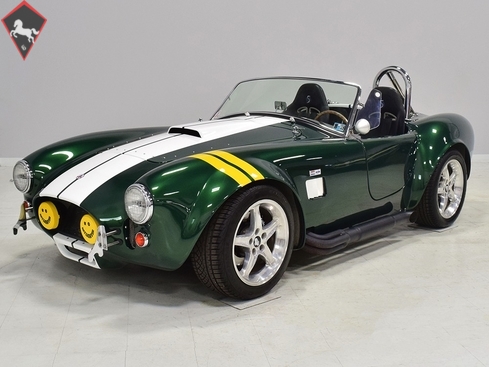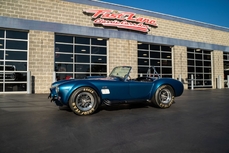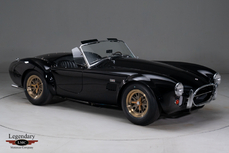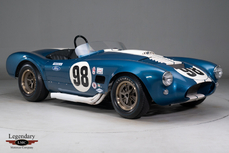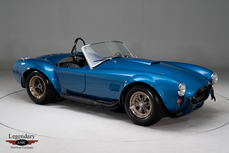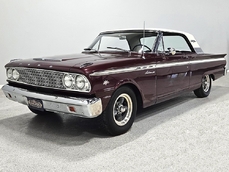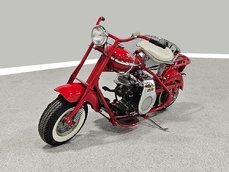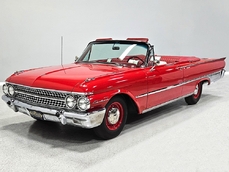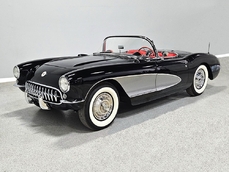Shelby Cobra 427 5.0 liter V8 1966
General description :
I don’t know why the Cobra is the most popular car of all time, but it is. The shape, the performance, the larger-than-life legend, whatever, but year after year, people keep building Cobras and they keep having fun with them on the street and on the track. Of course, they’re ideal hobby cars, being easy to maintain, quite durable, and if they’re built properly, reliable enough to drive every day. And few guys know how to bring it together better than Factory 5. They stumbled on an ingenious solution to the Cobra “kit” problem. a fully engineered kit that was designed to accept late-model Mustang 5.0 components. Forget the days of trying to figure out your own engine mounts and which transmission will make the shifter come out in the right place and how to get the correct steering geometry with junkyard parts. They’ve done all the engineering for you. Then add in the long list of Mustang 5.0 performance upgrades, the extreme durability of the hardware, and the inexpensive nature of parts, and suddenly you have a Cobra that can do it all.
This gorgeous Factory 5 Cobra is a great illustration of the virtues of factory engineering. It was built a few years ago but you can see that they guys doing the fiberglass work really did a nice job, because it’s smooth, the panels fit well, and there’s just no evidence that it’s ‘glass until you rap your knuckles on it. All the kit makers take a few liberties with the Cobra shape (nobody can tell without an original sitting nearby anyway), but the Factory 5 cars are more accurate than most and the stance on this one looks downright predatory. With two extra inches of wheelbase, there’s a bit more room inside, but again, you’ll never notice just standing next to it and the driver will be eternally grateful for the upgrade. The metallic green paint with white stripes is a traditional Cobra look and we like the somewhat subtle color combination. The addition of yellow hashmarks on the front fender is a nice touch, and recalls when these were actual race cars—hash marks were often used to help spotters tell the cars apart from a distance or at night. Other thoughtful details include the jacking stubs, mesh grilles over the headlights, and those massive KC Highlighter driving lights in the grille opening—talk about flamethrowers! For authenticity, this Cobra also wears appropriate “Powered by Ford” badges, bullet-style side mirror, and a flip-up gas cap on the rear quarter. Nobody will mistake it for anything else and it’s quite nicely finished and ready to rock.
The interior shows that this Cobra was built for combat, eschewing the original low-back buckets in favor of modern high-back racing shells with 5-point Simpson racing harnesses. The rest is familiar Cobra, from the simple door pockets to the flat dash wrapped in vinyl and filled with Auto Meter dials. A wood-rimmed steering wheel is quite authentic-looking and the drilled aluminum pedals are just plain cool. You’ll note this car includes a correct forward-canted shifter for the Tremec 5-speed underneath, as well as a full switch panel to control the various functions like lights, fuel pump, and other vitals. It is wired for a stereo, but there is no head unit, so you could add that if you like, but we suspect that the side pipes provide all the stereo accompaniment you’d want. It’s a bit of climb over the deep bucket seat, and there’s a bit of wear on that high-traffic spot, but the rest is in excellent condition and shows minimal signs of use. Once you’re in there, the driving position is superb, the pedals are well-arranged, and the steering feels hard-wired into your cerebellum. The trunk is neatly finished with carpets and a pair of charging stubs, but there is no top—in a Cobra, what’s the point?
This Cobra should last practically forever, because under the forward-tilting hood you’ll find a bone-stock 5.0 liter V8 from a 1993 Mustang Cobra. The distinctive intake manifold gives it away every time, but by keeping it stock, reliability is bulletproof. And with 1000 fewer pounds to haul around than in the already pretty quick Mustang, performance is electrifying. All the factory electronic controls are still in place, so it starts easily, idles well, and never gets fussy. A few dress-up parts like the finned aluminum valve covers recall the ‘60s while a giant radiator with an electric fan keeps it cool. A/C and power steering aren’t on the menu in a Cobra, but you do get nice features like a modern alternator, hood struts to keep the hood open (most Cobra kits use a prop rod), and a set of beautifully made exhaust headers that dump into those satin-black side pipes. Even with 302 cubes instead of 427, the sound is spectacular.
Factory 5’s chassis uses the same round tube ladder setup that the originals used, with CAD engineering to allow the Mustang components to bolt in place. There’s a Tremec 5-speed manual transmission with a stubby driveshaft spinning the Mustang’s 8.8-inch rear end, which feels like it has 3.73 gears inside—this sucker is PUNCHY! The front suspension uses custom coil-over shocks and tubular upper A-arms so ride height is adjustable, while the rear still uses the Mustang 4-link setup with coil-overs and quad shocks to tame the rear end. It works rather well, and this sucker does hook up hard! Brakes are beefy Wilwood discs all around, with the rears being brand new and installed at a cost of over $3000. Take a moment to note the beautiful aluminum panel work on the floors, the heavily reinforced chassis, and even the factory Mustang fuel tank hanging out back. You’ll have no problems servicing this Cobra and parts are available just about anywhere. Ride quality is surprisingly good for a Cobra and with so little weight, acceleration and braking will strain your neck muscles. And while Halibrands are cool, the 17-inch Cobra R wheels on this Cobra work extremely well and carry brand new 245/45/17 front and 275/40/17 rear continental performance radials.
There’s certainly a pecking order when it comes to Cobra kits, but this green Cobra is right in the sweet spot: still affordable, still fast, and extremely easy to own. You couldn’t build this car for the asking price and given the lead times on kits, you could be having fun right away rather than two or three years from now, and that sounds like the best idea of all. Call today!
http://www.harwoodmotors.com/vehicles/inventory_details.php?id=1020
1966 Shelby Cobra 427 5.0 liter V8 is listed sold on ClassicDigest in Macedonia by for $47900.
Car Facts
Car type : Car Make : Shelby Model : Cobra 427 Model Version : 5.0 liter V8 Engine size : 5.0 Model Year : 1966 Location : Ohio
Sold
Seller Information
Sold
People who viewed this Shelby Cobra 427 also viewed similar Shelby listed at ClassicDigest
Other cars listed for sale by this dealer
About Shelby
Carroll Shelby, a legendary figure in the automotive world, had a remarkable journey from being a successful race car driver to becoming a renowned sports car manufacturer in the United States. His story is filled with achievements, innovations, and iconic cars that left an indelible mark on the industry.Early Years and Racing Career:
Carroll Shelby was born in 1923 in Texas. He initially pursued a career as a pilot during World War II but found his true passion in racing after the war. Shelby became a successful race car driver in the 1950s, competing in various events including Formula One, endurance racing, and the famous 24 Hours of Le Mans.
Shelby Cobras - Iconic Sports Cars:
Carroll Shelby's pivotal moment as a manufacturer came with the creation of the Shelby Cobra, an iconic American sports car. The Cobra was born from the fusion of a British AC Ace chassis and a Ford V8 engine, creating a lightweight, high-performance car that dominated tracks and streets alike. Key models include:
Shelby Cobra 260 (1962): The initial version with a 260 cubic inch (4.2L) V8 engine.
Shelby Cobra 289 (1963-1965): Later iterations with a 289 cubic inch (4.7L) V8 engine, including the competition-spec Cobras known for their racing prowess.
Shelby Cobra 427 (1965-1967): The most powerful iteration with a 427 cubic inch (7.0L) V8 engine, known for its raw power and performance.
Ford Partnership - Shelby Mustangs:
Shelby's partnership with Ford led to the creation of legendary Shelby Mustangs. The most notable model is:
Shelby GT350 (1965-1969): Based on the Ford Mustang, the GT350 was modified by Shelby American, featuring enhanced performance, handling, and distinct styling.
Other Notable Models and Achievements:
Beyond the Cobras and Mustangs, Shelby had several other significant contributions:
Shelby Daytona Coupe: Created to win against Ferrari in international GT racing, this car became the first American car to win the FIA GT World Championship in 1965.
Shelby Series 1: Introduced in the late 1990s, this was Shelby's modern take on a high-performance sports car.
Ford GT40 plays a pivotal role in Carroll Shelby's narrative, especially in his connection to Ford and his significant contribution to the car's success.
The Ford GT40 Development:
Ford's Challenge:
In the early 1960s, Henry Ford II sought to acquire Ferrari, but negotiations fell apart. This spurred Ford's determination to beat Ferrari at the prestigious 24 Hours of Le Mans endurance race, which Ferrari had dominated for several years.
Collaboration with Shelby:
Ford turned to Carroll Shelby, recognizing his racing expertise and track record. Shelby was tasked with leading the GT40 project and turning it into a competitive race car capable of challenging Ferrari's supremacy.
Development and Triumph:
Under Shelby's guidance, the Ford GT40 underwent rigorous development to address initial design flaws and performance issues. Several iterations were produced:
Early Attempts: The initial versions of the GT40 faced reliability and handling issues, leading to disappointing results at Le Mans in 1964.
GT40 Mark II: Shelby's team made crucial improvements. The Mark II, equipped with a powerful V8 engine, improved aerodynamics, and refined engineering, became highly competitive.
Le Mans Victory:
In 1966, the Ford GT40 Mark II achieved a historic victory at the 24 Hours of Le Mans, with Shelby-coached driver Ken Miles leading the race. This marked the first win for an American manufacturer at Le Mans, breaking Ferrari's dominance.
Continued Success:
The GT40 continued to dominate, winning Le Mans for the following three years (1966-1969), securing its place in racing history and solidifying Ford's reputation as a force in international motorsport.
Shelby's Contribution to the GT40 Success:
While Carroll Shelby wasn't directly involved in designing the GT40, his expertise in racing and his ability to assemble and lead a team of talented engineers, mechanics, and drivers were instrumental in refining the car's performance. His influence helped address technical issues, refine the car's handling, and strategize race tactics, contributing significantly to the GT40's success on the track.
Legacy and Impact:
The Ford GT40's victories at Le Mans under Shelby's guidance remain one of the most iconic achievements in motorsport history. The car's success solidified Shelby's reputation as an automotive visionary and further strengthened his partnership with Ford.
Carroll Shelby's involvement in the GT40 project showcased his ability to transform a struggling project into a championship-winning machine, adding another remarkable chapter to his illustrious career in the automotive world.
